The Impact of Citigroup Inc.'s Reverse Stock Split: An Analysis
VerifiedAdded on 2023/04/23
|8
|1473
|221
Report
AI Summary
This report analyzes the reverse stock split of Citigroup Inc., examining the reasons behind the split, its impact on the stock price, and its effects on earnings per share (EPS). The report begins with an introduction to reverse stock splits and their purpose, followed by an analysis of Citigroup's specific case, including the 1-for-10 reverse split in 2011. The analysis covers the price changes, the impact on net income and EPS, and the judgment behind the decision. The report references financial data from 2008 to 2010, highlighting the company's financial performance before and after the split. It discusses the positive and negative implications for investors and the company's strategic goals. The conclusion summarizes the overall impact of the reverse stock split on Citigroup and its stakeholders. The report also includes a list of references used in the analysis.
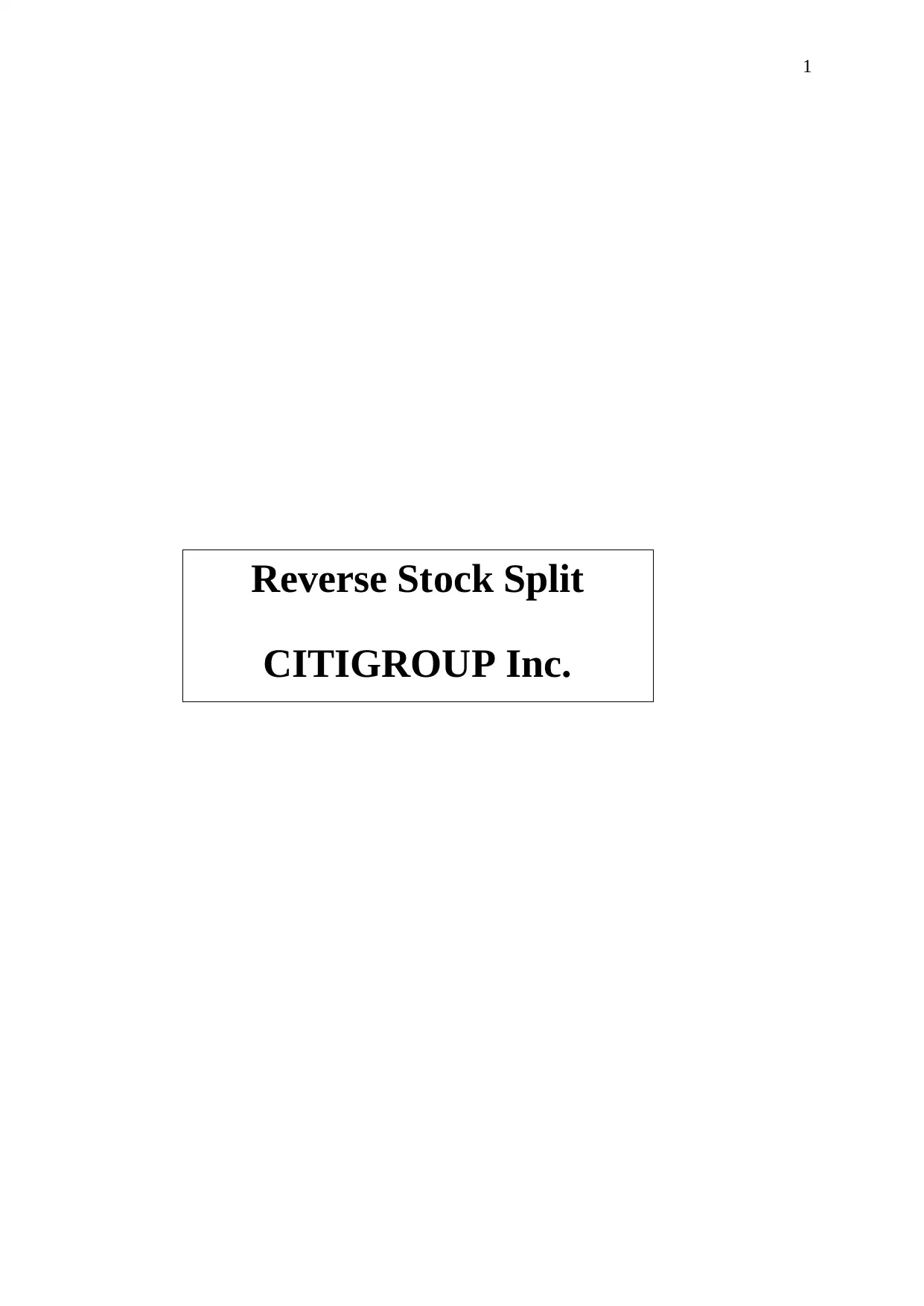
1
Reverse Stock Split
CITIGROUP Inc.
Reverse Stock Split
CITIGROUP Inc.
Paraphrase This Document
Need a fresh take? Get an instant paraphrase of this document with our AI Paraphraser
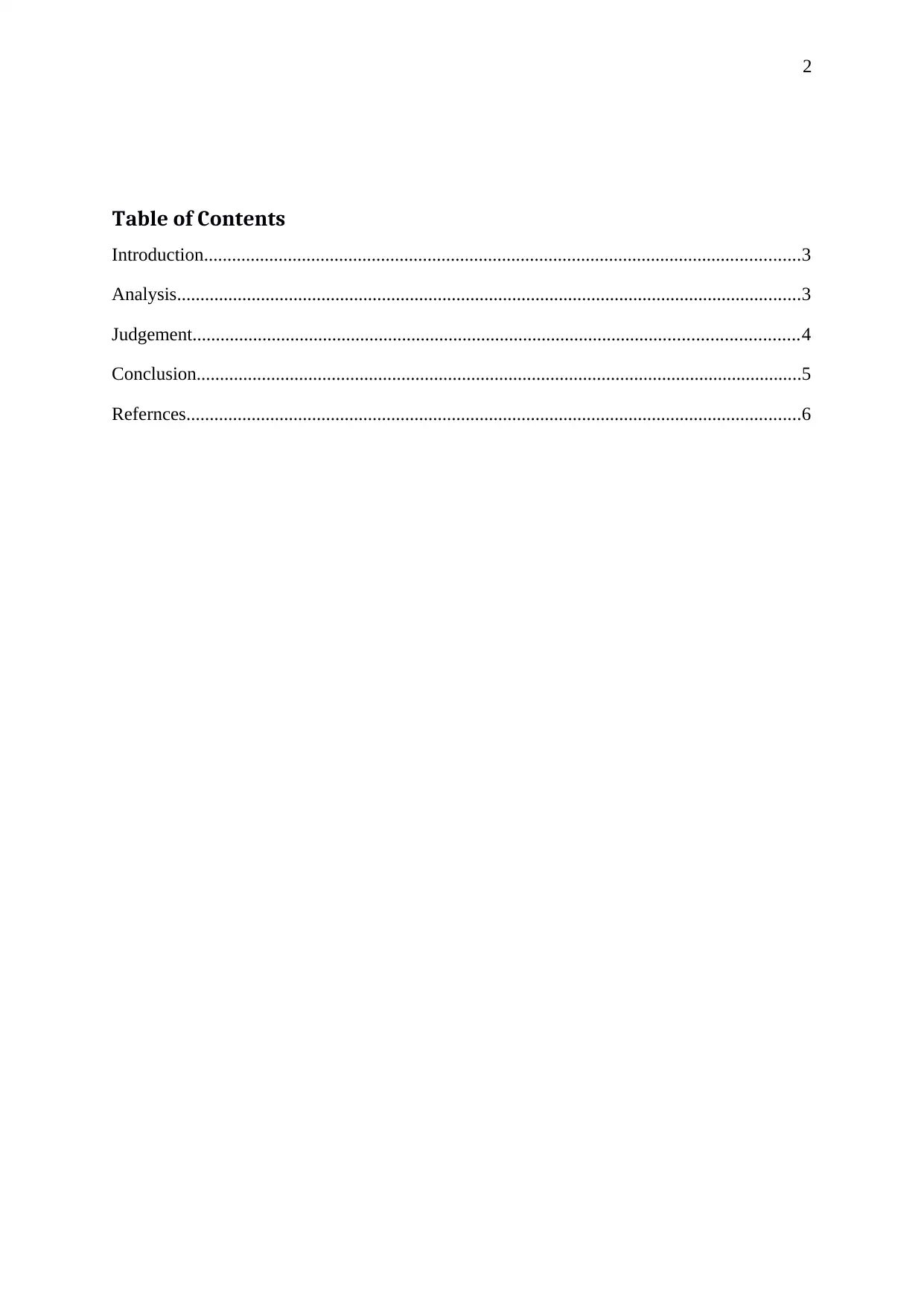
2
Table of Contents
Introduction................................................................................................................................3
Analysis......................................................................................................................................3
Judgement..................................................................................................................................4
Conclusion..................................................................................................................................5
Refernces....................................................................................................................................6
Table of Contents
Introduction................................................................................................................................3
Analysis......................................................................................................................................3
Judgement..................................................................................................................................4
Conclusion..................................................................................................................................5
Refernces....................................................................................................................................6
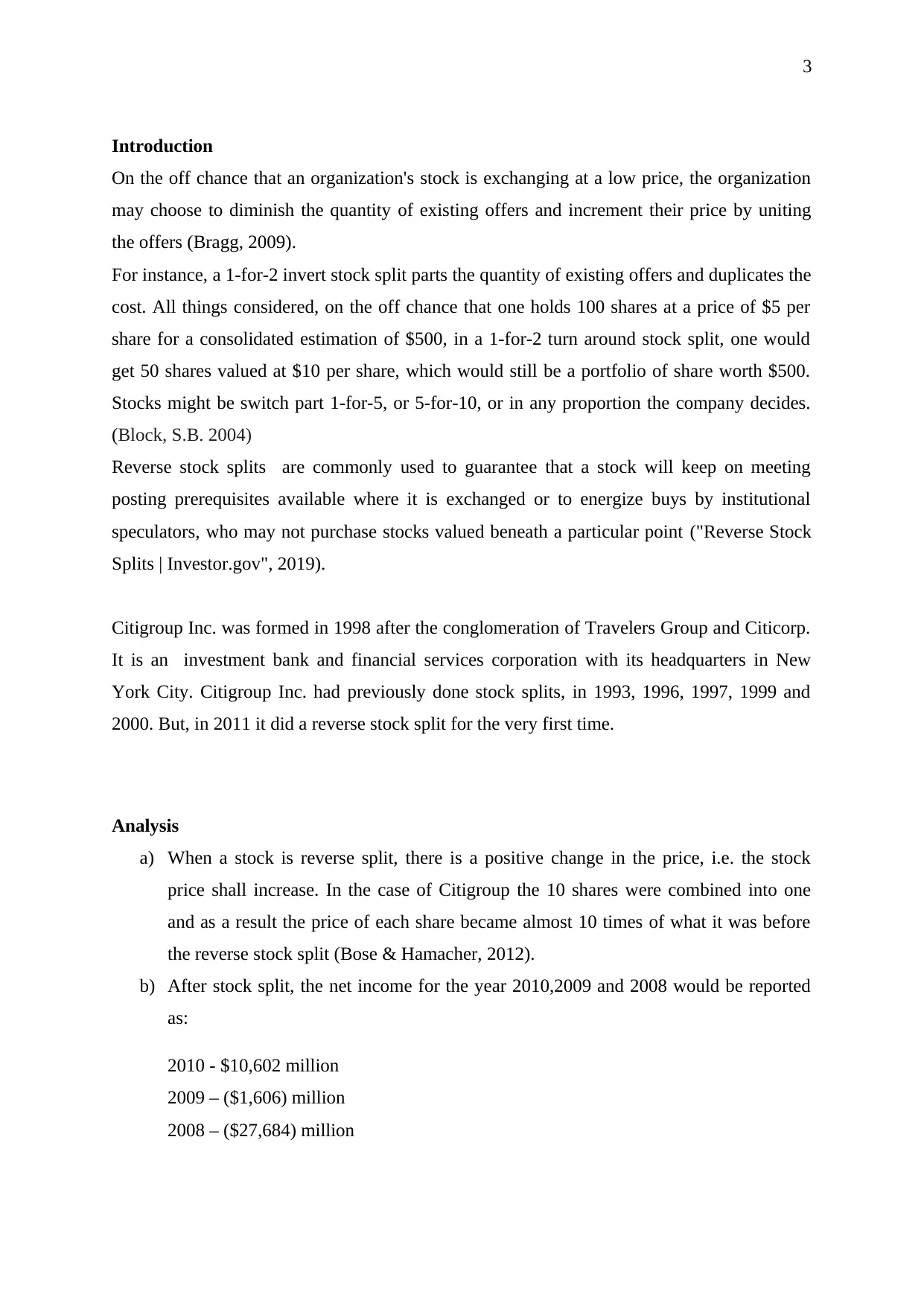
3
Introduction
On the off chance that an organization's stock is exchanging at a low price, the organization
may choose to diminish the quantity of existing offers and increment their price by uniting
the offers (Bragg, 2009).
For instance, a 1-for-2 invert stock split parts the quantity of existing offers and duplicates the
cost. All things considered, on the off chance that one holds 100 shares at a price of $5 per
share for a consolidated estimation of $500, in a 1-for-2 turn around stock split, one would
get 50 shares valued at $10 per share, which would still be a portfolio of share worth $500.
Stocks might be switch part 1-for-5, or 5-for-10, or in any proportion the company decides.
(Block, S.B. 2004)
Reverse stock splits are commonly used to guarantee that a stock will keep on meeting
posting prerequisites available where it is exchanged or to energize buys by institutional
speculators, who may not purchase stocks valued beneath a particular point ("Reverse Stock
Splits | Investor.gov", 2019).
Citigroup Inc. was formed in 1998 after the conglomeration of Travelers Group and Citicorp.
It is an investment bank and financial services corporation with its headquarters in New
York City. Citigroup Inc. had previously done stock splits, in 1993, 1996, 1997, 1999 and
2000. But, in 2011 it did a reverse stock split for the very first time.
Analysis
a) When a stock is reverse split, there is a positive change in the price, i.e. the stock
price shall increase. In the case of Citigroup the 10 shares were combined into one
and as a result the price of each share became almost 10 times of what it was before
the reverse stock split (Bose & Hamacher, 2012).
b) After stock split, the net income for the year 2010,2009 and 2008 would be reported
as:
2010 - $10,602 million
2009 – ($1,606) million
2008 – ($27,684) million
Introduction
On the off chance that an organization's stock is exchanging at a low price, the organization
may choose to diminish the quantity of existing offers and increment their price by uniting
the offers (Bragg, 2009).
For instance, a 1-for-2 invert stock split parts the quantity of existing offers and duplicates the
cost. All things considered, on the off chance that one holds 100 shares at a price of $5 per
share for a consolidated estimation of $500, in a 1-for-2 turn around stock split, one would
get 50 shares valued at $10 per share, which would still be a portfolio of share worth $500.
Stocks might be switch part 1-for-5, or 5-for-10, or in any proportion the company decides.
(Block, S.B. 2004)
Reverse stock splits are commonly used to guarantee that a stock will keep on meeting
posting prerequisites available where it is exchanged or to energize buys by institutional
speculators, who may not purchase stocks valued beneath a particular point ("Reverse Stock
Splits | Investor.gov", 2019).
Citigroup Inc. was formed in 1998 after the conglomeration of Travelers Group and Citicorp.
It is an investment bank and financial services corporation with its headquarters in New
York City. Citigroup Inc. had previously done stock splits, in 1993, 1996, 1997, 1999 and
2000. But, in 2011 it did a reverse stock split for the very first time.
Analysis
a) When a stock is reverse split, there is a positive change in the price, i.e. the stock
price shall increase. In the case of Citigroup the 10 shares were combined into one
and as a result the price of each share became almost 10 times of what it was before
the reverse stock split (Bose & Hamacher, 2012).
b) After stock split, the net income for the year 2010,2009 and 2008 would be reported
as:
2010 - $10,602 million
2009 – ($1,606) million
2008 – ($27,684) million
⊘ This is a preview!⊘
Do you want full access?
Subscribe today to unlock all pages.

Trusted by 1+ million students worldwide
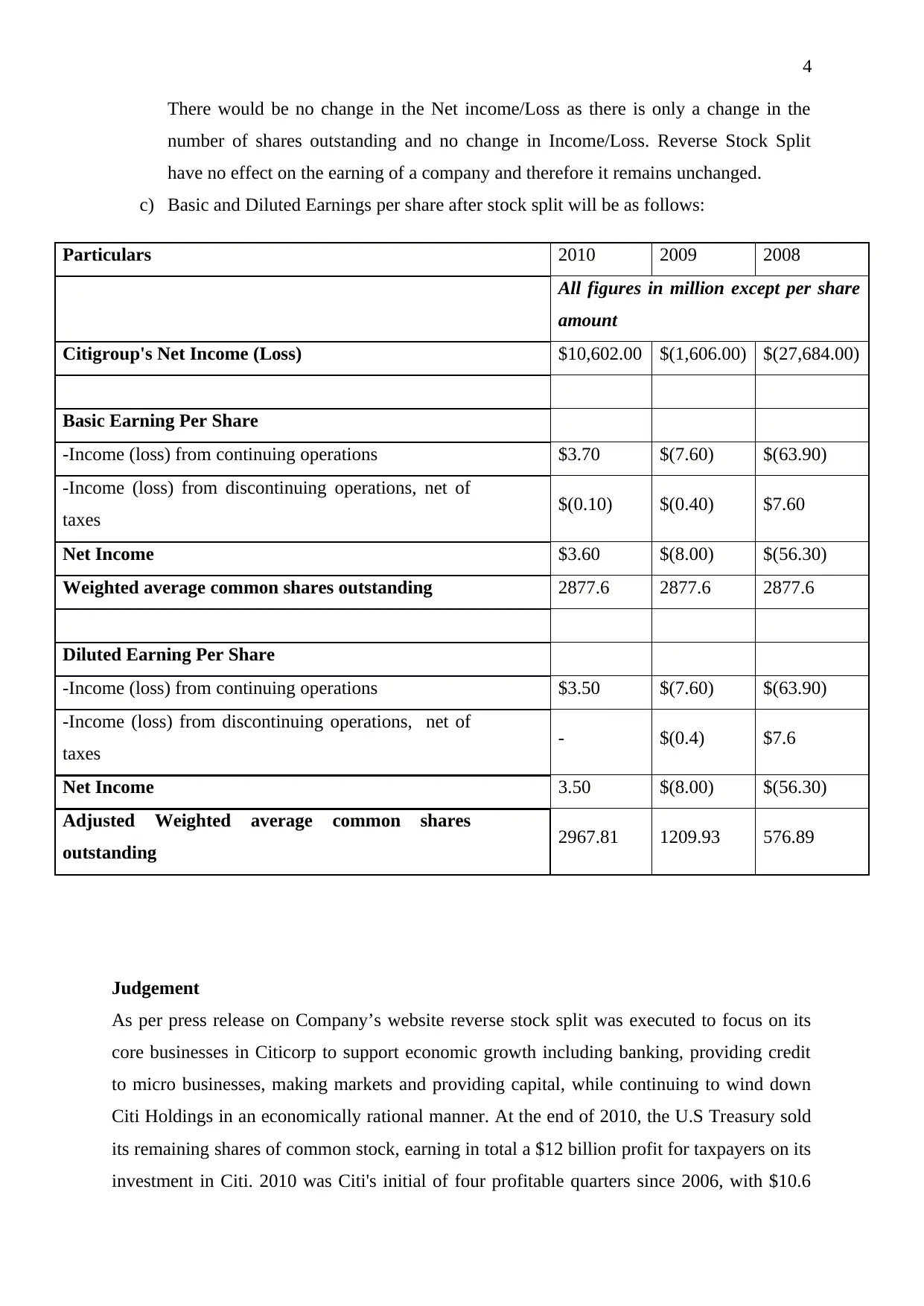
4
There would be no change in the Net income/Loss as there is only a change in the
number of shares outstanding and no change in Income/Loss. Reverse Stock Split
have no effect on the earning of a company and therefore it remains unchanged.
c) Basic and Diluted Earnings per share after stock split will be as follows:
Particulars 2010 2009 2008
All figures in million except per share
amount
Citigroup's Net Income (Loss) $10,602.00 $(1,606.00) $(27,684.00)
Basic Earning Per Share
-Income (loss) from continuing operations $3.70 $(7.60) $(63.90)
-Income (loss) from discontinuing operations, net of
taxes $(0.10) $(0.40) $7.60
Net Income $3.60 $(8.00) $(56.30)
Weighted average common shares outstanding 2877.6 2877.6 2877.6
Diluted Earning Per Share
-Income (loss) from continuing operations $3.50 $(7.60) $(63.90)
-Income (loss) from discontinuing operations, net of
taxes - $(0.4) $7.6
Net Income 3.50 $(8.00) $(56.30)
Adjusted Weighted average common shares
outstanding 2967.81 1209.93 576.89
Judgement
As per press release on Company’s website reverse stock split was executed to focus on its
core businesses in Citicorp to support economic growth including banking, providing credit
to micro businesses, making markets and providing capital, while continuing to wind down
Citi Holdings in an economically rational manner. At the end of 2010, the U.S Treasury sold
its remaining shares of common stock, earning in total a $12 billion profit for taxpayers on its
investment in Citi. 2010 was Citi's initial of four profitable quarters since 2006, with $10.6
There would be no change in the Net income/Loss as there is only a change in the
number of shares outstanding and no change in Income/Loss. Reverse Stock Split
have no effect on the earning of a company and therefore it remains unchanged.
c) Basic and Diluted Earnings per share after stock split will be as follows:
Particulars 2010 2009 2008
All figures in million except per share
amount
Citigroup's Net Income (Loss) $10,602.00 $(1,606.00) $(27,684.00)
Basic Earning Per Share
-Income (loss) from continuing operations $3.70 $(7.60) $(63.90)
-Income (loss) from discontinuing operations, net of
taxes $(0.10) $(0.40) $7.60
Net Income $3.60 $(8.00) $(56.30)
Weighted average common shares outstanding 2877.6 2877.6 2877.6
Diluted Earning Per Share
-Income (loss) from continuing operations $3.50 $(7.60) $(63.90)
-Income (loss) from discontinuing operations, net of
taxes - $(0.4) $7.6
Net Income 3.50 $(8.00) $(56.30)
Adjusted Weighted average common shares
outstanding 2967.81 1209.93 576.89
Judgement
As per press release on Company’s website reverse stock split was executed to focus on its
core businesses in Citicorp to support economic growth including banking, providing credit
to micro businesses, making markets and providing capital, while continuing to wind down
Citi Holdings in an economically rational manner. At the end of 2010, the U.S Treasury sold
its remaining shares of common stock, earning in total a $12 billion profit for taxpayers on its
investment in Citi. 2010 was Citi's initial of four profitable quarters since 2006, with $10.6
Paraphrase This Document
Need a fresh take? Get an instant paraphrase of this document with our AI Paraphraser
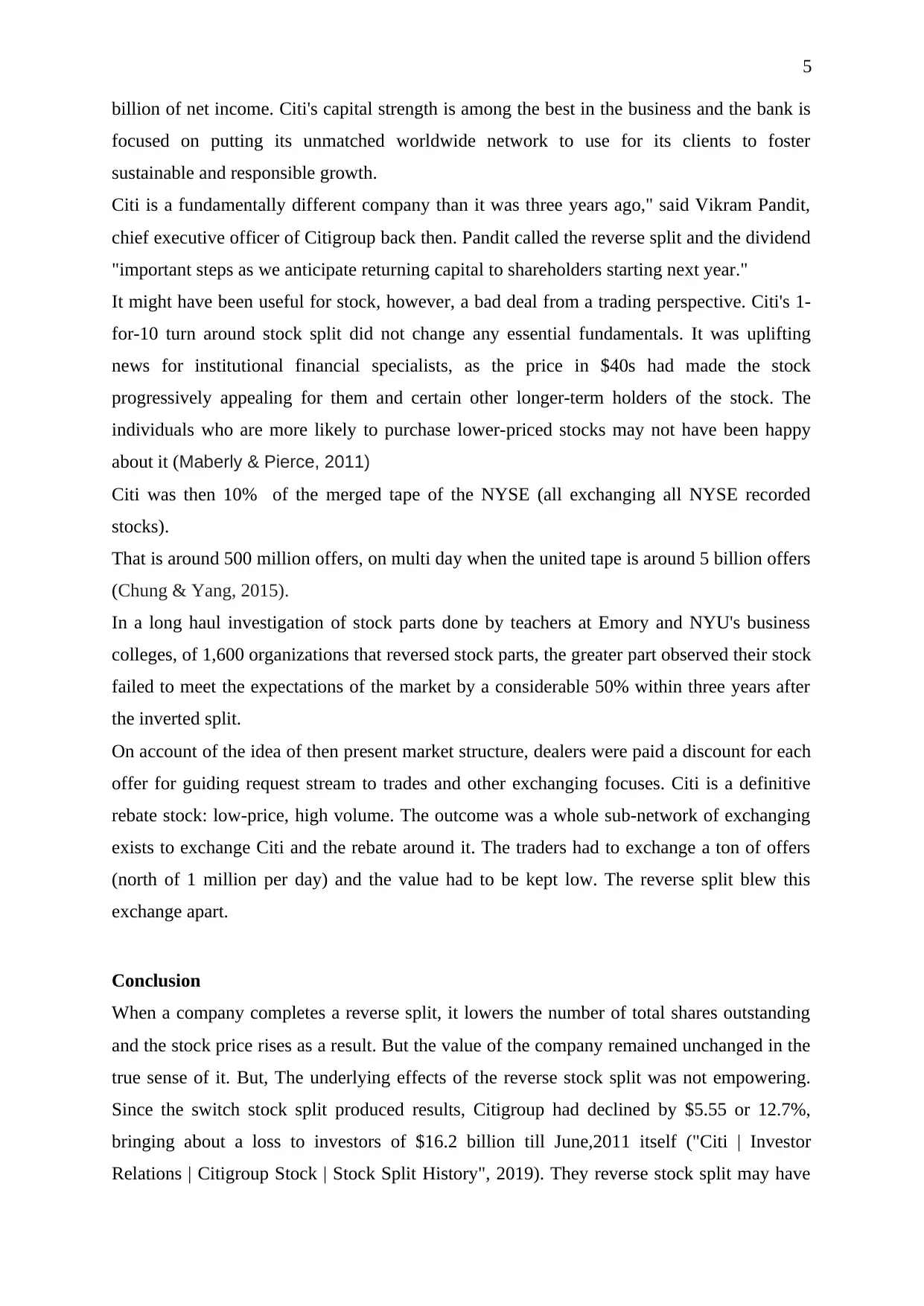
5
billion of net income. Citi's capital strength is among the best in the business and the bank is
focused on putting its unmatched worldwide network to use for its clients to foster
sustainable and responsible growth.
Citi is a fundamentally different company than it was three years ago," said Vikram Pandit,
chief executive officer of Citigroup back then. Pandit called the reverse split and the dividend
"important steps as we anticipate returning capital to shareholders starting next year."
It might have been useful for stock, however, a bad deal from a trading perspective. Citi's 1-
for-10 turn around stock split did not change any essential fundamentals. It was uplifting
news for institutional financial specialists, as the price in $40s had made the stock
progressively appealing for them and certain other longer-term holders of the stock. The
individuals who are more likely to purchase lower-priced stocks may not have been happy
about it (Maberly & Pierce, 2011)
Citi was then 10% of the merged tape of the NYSE (all exchanging all NYSE recorded
stocks).
That is around 500 million offers, on multi day when the united tape is around 5 billion offers
(Chung & Yang, 2015).
In a long haul investigation of stock parts done by teachers at Emory and NYU's business
colleges, of 1,600 organizations that reversed stock parts, the greater part observed their stock
failed to meet the expectations of the market by a considerable 50% within three years after
the inverted split.
On account of the idea of then present market structure, dealers were paid a discount for each
offer for guiding request stream to trades and other exchanging focuses. Citi is a definitive
rebate stock: low-price, high volume. The outcome was a whole sub-network of exchanging
exists to exchange Citi and the rebate around it. The traders had to exchange a ton of offers
(north of 1 million per day) and the value had to be kept low. The reverse split blew this
exchange apart.
Conclusion
When a company completes a reverse split, it lowers the number of total shares outstanding
and the stock price rises as a result. But the value of the company remained unchanged in the
true sense of it. But, The underlying effects of the reverse stock split was not empowering.
Since the switch stock split produced results, Citigroup had declined by $5.55 or 12.7%,
bringing about a loss to investors of $16.2 billion till June,2011 itself ("Citi | Investor
Relations | Citigroup Stock | Stock Split History", 2019). They reverse stock split may have
billion of net income. Citi's capital strength is among the best in the business and the bank is
focused on putting its unmatched worldwide network to use for its clients to foster
sustainable and responsible growth.
Citi is a fundamentally different company than it was three years ago," said Vikram Pandit,
chief executive officer of Citigroup back then. Pandit called the reverse split and the dividend
"important steps as we anticipate returning capital to shareholders starting next year."
It might have been useful for stock, however, a bad deal from a trading perspective. Citi's 1-
for-10 turn around stock split did not change any essential fundamentals. It was uplifting
news for institutional financial specialists, as the price in $40s had made the stock
progressively appealing for them and certain other longer-term holders of the stock. The
individuals who are more likely to purchase lower-priced stocks may not have been happy
about it (Maberly & Pierce, 2011)
Citi was then 10% of the merged tape of the NYSE (all exchanging all NYSE recorded
stocks).
That is around 500 million offers, on multi day when the united tape is around 5 billion offers
(Chung & Yang, 2015).
In a long haul investigation of stock parts done by teachers at Emory and NYU's business
colleges, of 1,600 organizations that reversed stock parts, the greater part observed their stock
failed to meet the expectations of the market by a considerable 50% within three years after
the inverted split.
On account of the idea of then present market structure, dealers were paid a discount for each
offer for guiding request stream to trades and other exchanging focuses. Citi is a definitive
rebate stock: low-price, high volume. The outcome was a whole sub-network of exchanging
exists to exchange Citi and the rebate around it. The traders had to exchange a ton of offers
(north of 1 million per day) and the value had to be kept low. The reverse split blew this
exchange apart.
Conclusion
When a company completes a reverse split, it lowers the number of total shares outstanding
and the stock price rises as a result. But the value of the company remained unchanged in the
true sense of it. But, The underlying effects of the reverse stock split was not empowering.
Since the switch stock split produced results, Citigroup had declined by $5.55 or 12.7%,
bringing about a loss to investors of $16.2 billion till June,2011 itself ("Citi | Investor
Relations | Citigroup Stock | Stock Split History", 2019). They reverse stock split may have
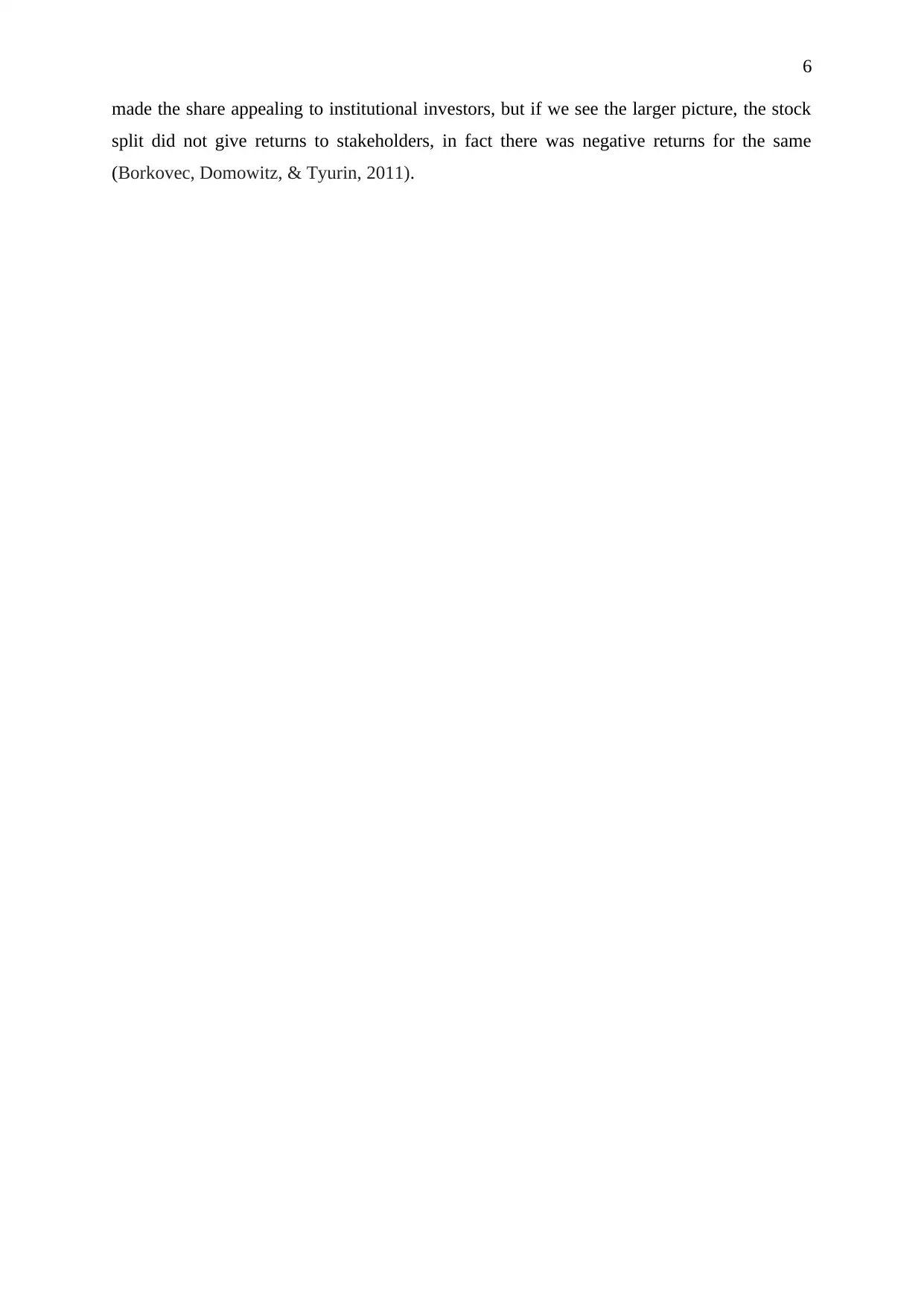
6
made the share appealing to institutional investors, but if we see the larger picture, the stock
split did not give returns to stakeholders, in fact there was negative returns for the same
(Borkovec, Domowitz, & Tyurin, 2011).
made the share appealing to institutional investors, but if we see the larger picture, the stock
split did not give returns to stakeholders, in fact there was negative returns for the same
(Borkovec, Domowitz, & Tyurin, 2011).
⊘ This is a preview!⊘
Do you want full access?
Subscribe today to unlock all pages.

Trusted by 1+ million students worldwide

7
Paraphrase This Document
Need a fresh take? Get an instant paraphrase of this document with our AI Paraphraser
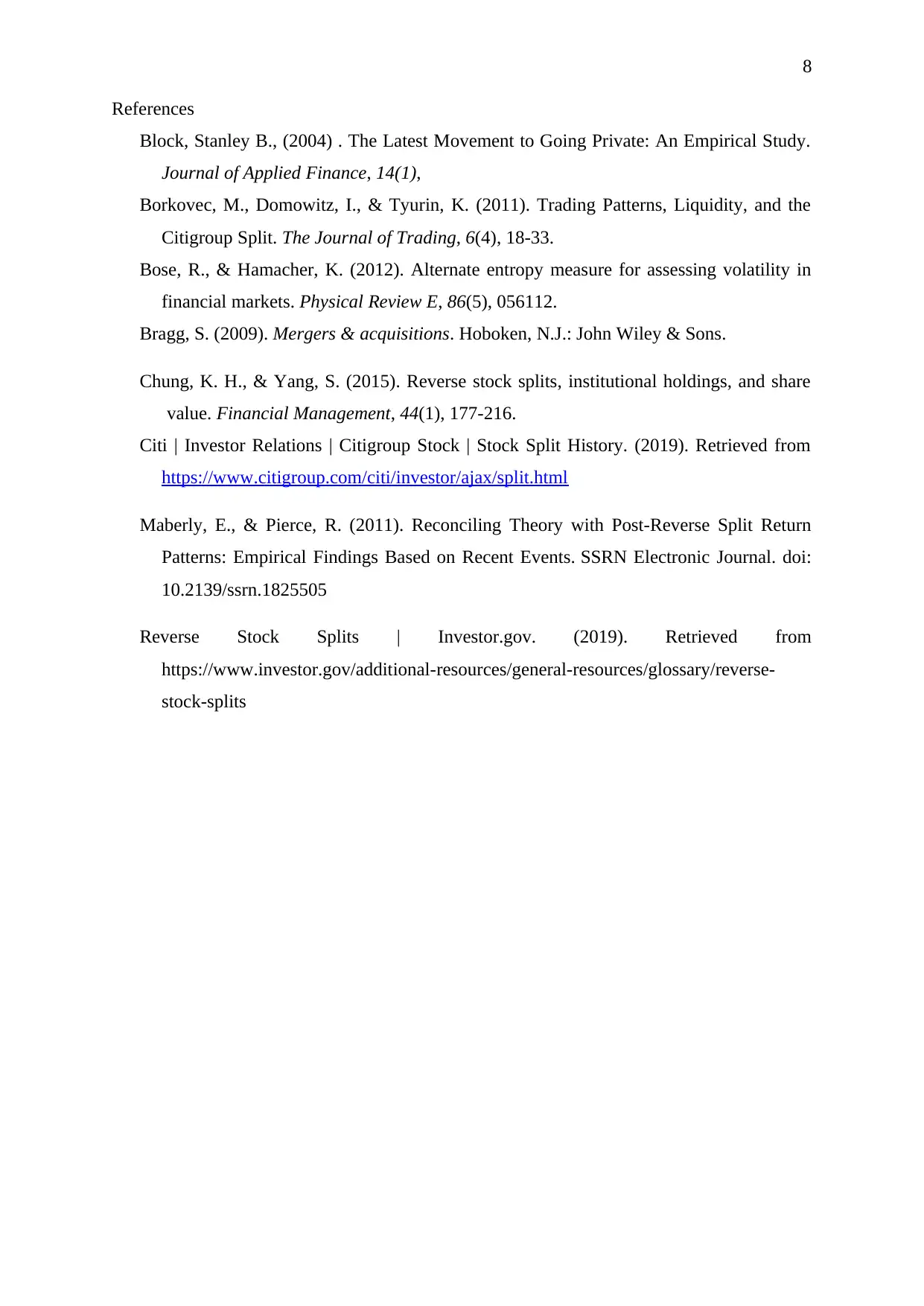
8
References
Block, Stanley B., (2004) . The Latest Movement to Going Private: An Empirical Study.
Journal of Applied Finance, 14(1),
Borkovec, M., Domowitz, I., & Tyurin, K. (2011). Trading Patterns, Liquidity, and the
Citigroup Split. The Journal of Trading, 6(4), 18-33.
Bose, R., & Hamacher, K. (2012). Alternate entropy measure for assessing volatility in
financial markets. Physical Review E, 86(5), 056112.
Bragg, S. (2009). Mergers & acquisitions. Hoboken, N.J.: John Wiley & Sons.
Chung, K. H., & Yang, S. (2015). Reverse stock splits, institutional holdings, and share
value. Financial Management, 44(1), 177-216.
Citi | Investor Relations | Citigroup Stock | Stock Split History. (2019). Retrieved from
https://www.citigroup.com/citi/investor/ajax/split.html
Maberly, E., & Pierce, R. (2011). Reconciling Theory with Post-Reverse Split Return
Patterns: Empirical Findings Based on Recent Events. SSRN Electronic Journal. doi:
10.2139/ssrn.1825505
Reverse Stock Splits | Investor.gov. (2019). Retrieved from
https://www.investor.gov/additional-resources/general-resources/glossary/reverse-
stock-splits
References
Block, Stanley B., (2004) . The Latest Movement to Going Private: An Empirical Study.
Journal of Applied Finance, 14(1),
Borkovec, M., Domowitz, I., & Tyurin, K. (2011). Trading Patterns, Liquidity, and the
Citigroup Split. The Journal of Trading, 6(4), 18-33.
Bose, R., & Hamacher, K. (2012). Alternate entropy measure for assessing volatility in
financial markets. Physical Review E, 86(5), 056112.
Bragg, S. (2009). Mergers & acquisitions. Hoboken, N.J.: John Wiley & Sons.
Chung, K. H., & Yang, S. (2015). Reverse stock splits, institutional holdings, and share
value. Financial Management, 44(1), 177-216.
Citi | Investor Relations | Citigroup Stock | Stock Split History. (2019). Retrieved from
https://www.citigroup.com/citi/investor/ajax/split.html
Maberly, E., & Pierce, R. (2011). Reconciling Theory with Post-Reverse Split Return
Patterns: Empirical Findings Based on Recent Events. SSRN Electronic Journal. doi:
10.2139/ssrn.1825505
Reverse Stock Splits | Investor.gov. (2019). Retrieved from
https://www.investor.gov/additional-resources/general-resources/glossary/reverse-
stock-splits
1 out of 8
Related Documents
Your All-in-One AI-Powered Toolkit for Academic Success.
+13062052269
info@desklib.com
Available 24*7 on WhatsApp / Email
![[object Object]](/_next/static/media/star-bottom.7253800d.svg)
Unlock your academic potential
Copyright © 2020–2025 A2Z Services. All Rights Reserved. Developed and managed by ZUCOL.
![Financial Statement Analysis Assignment - [University Name]](/_next/image/?url=https%3A%2F%2Fdesklib.com%2Fmedia%2Fimages%2Fsl%2F5d5358bf8f1949d98483d05ce8d0e6de.jpg&w=256&q=75)


